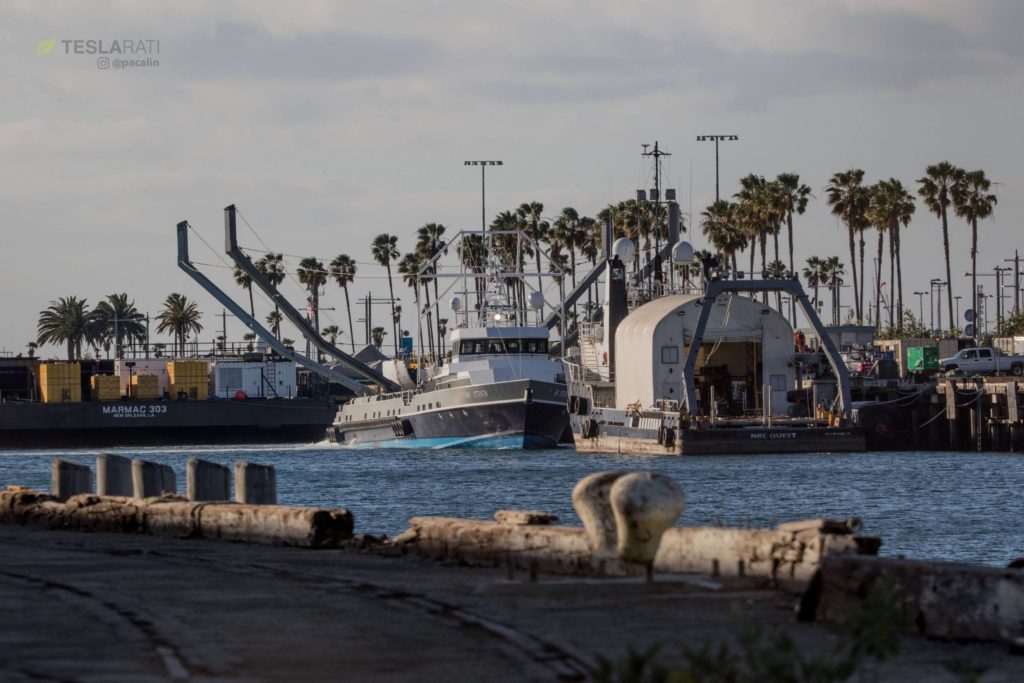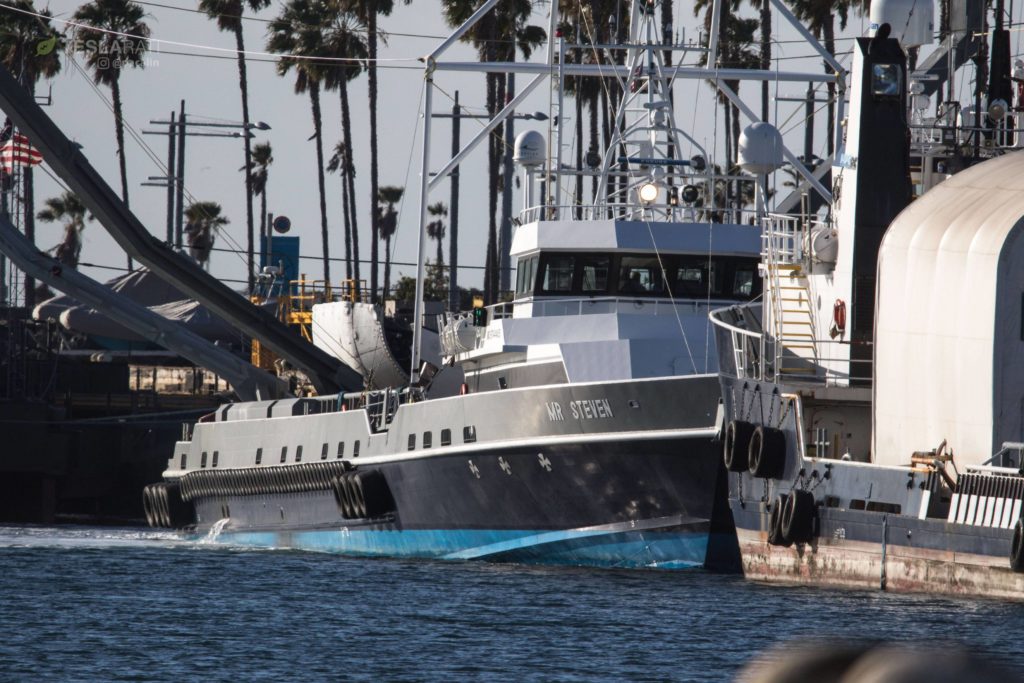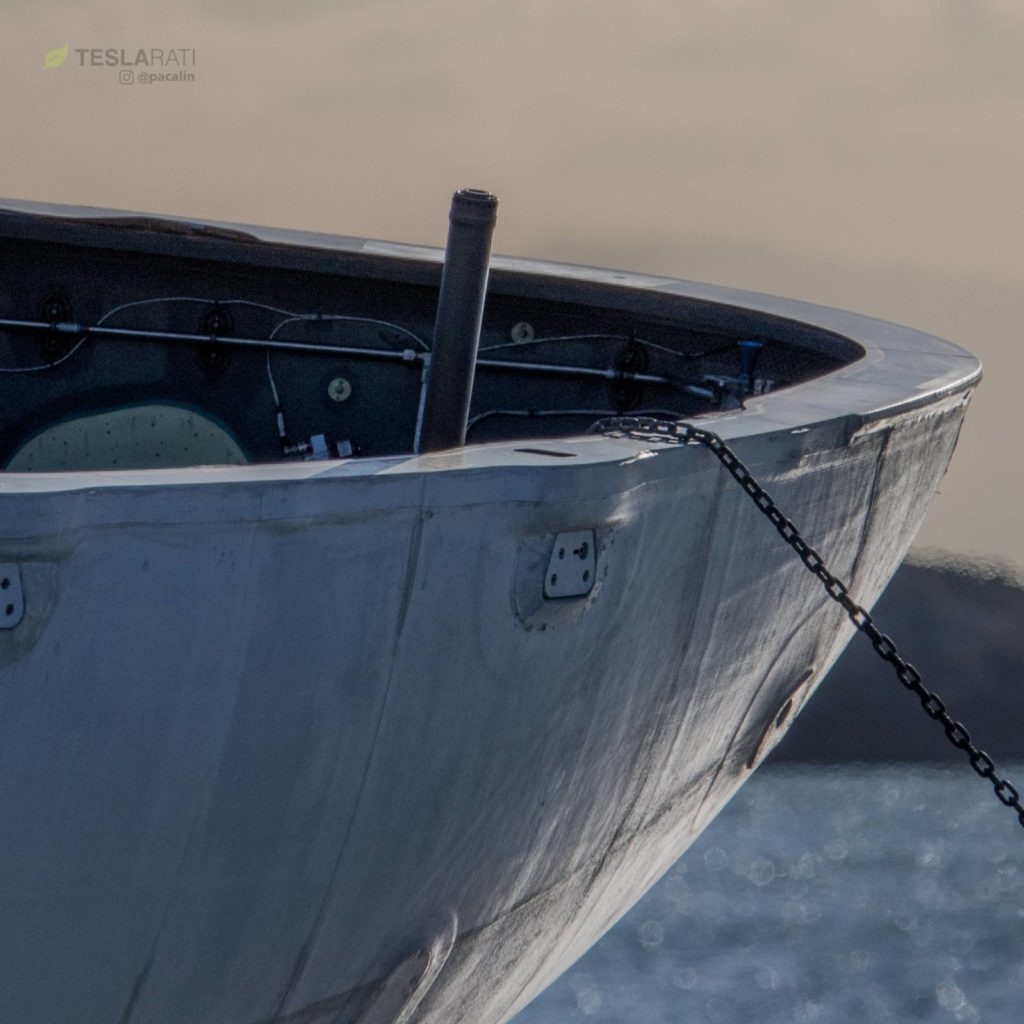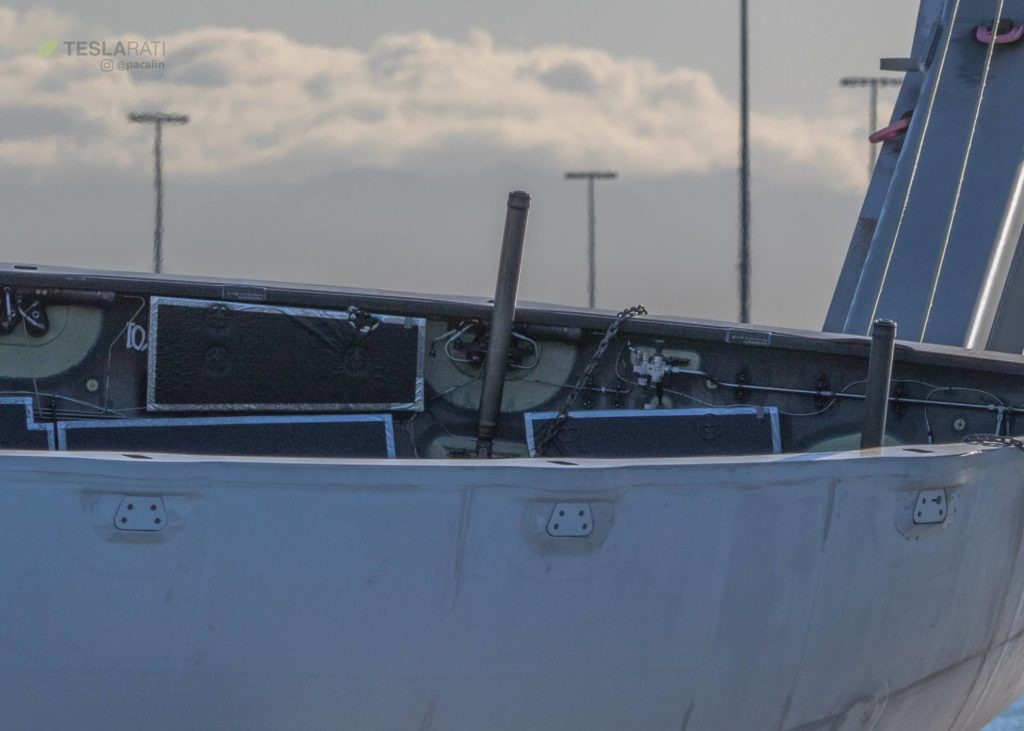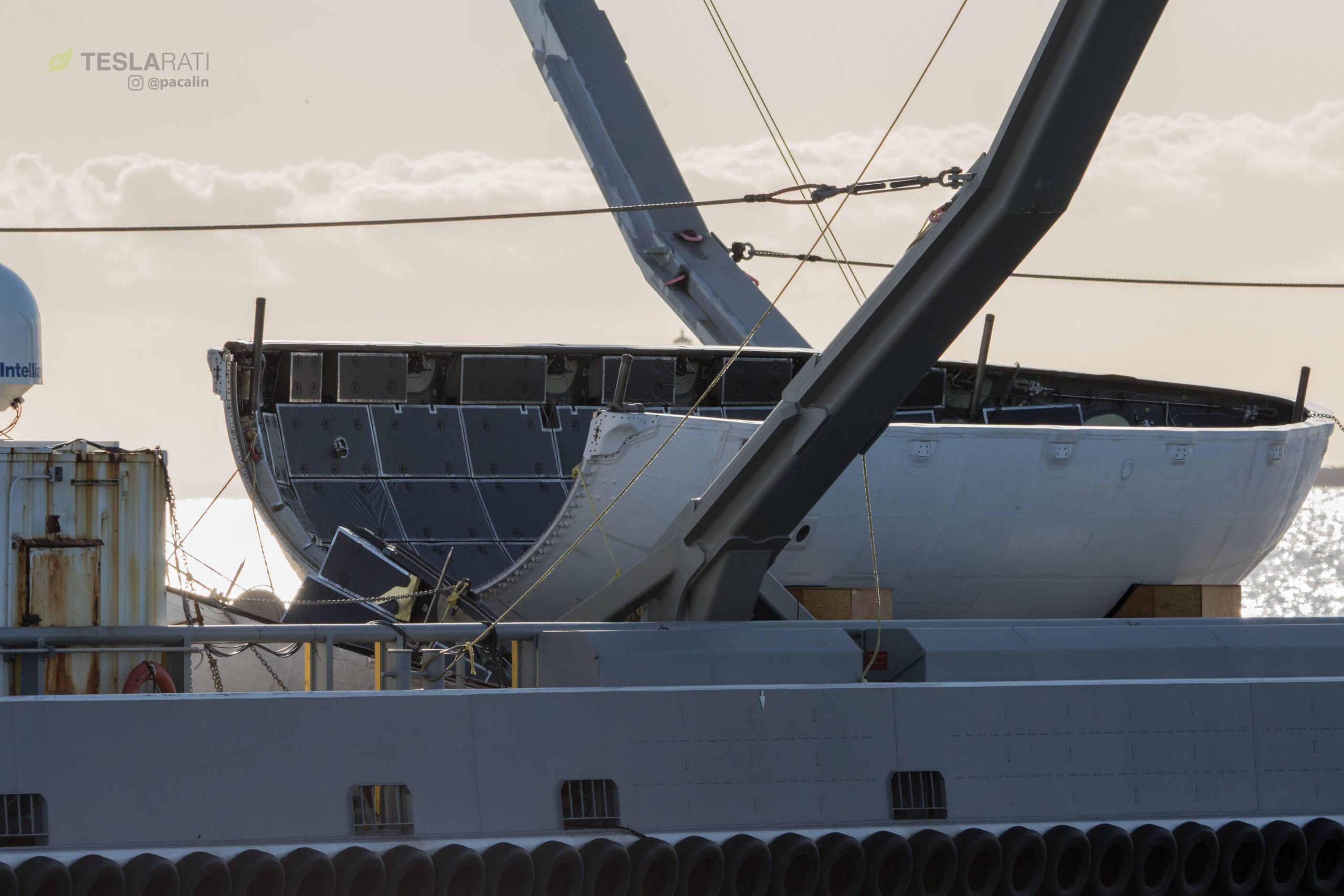
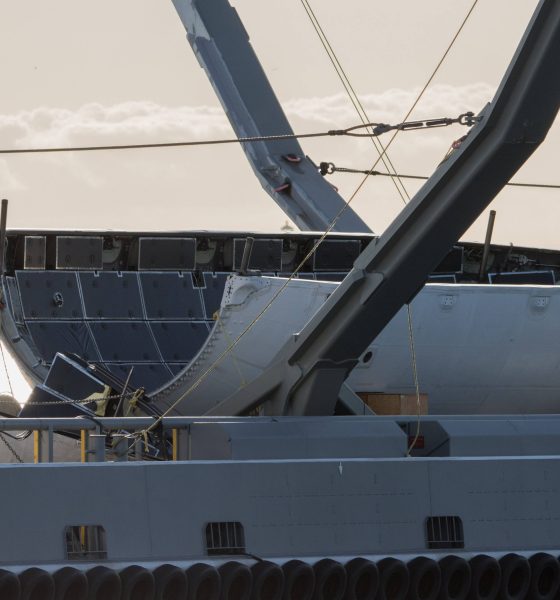
News
SpaceX’s recovered fairing spotted sailing into port on Mr Steven
Just 24 hours after gently landing in the ocean, SpaceX recovery technicians have successfully recovered one half of an intact Falcon payload fairing for the first time ever. Photos of the return to Port of San Pedro in Southern California, captured by Teslarati photographer Pauline Acalin, show that the halve recovered is in amazing condition considering its journey from speeds of nearly two miles per second (approximately 30 football fields per second, or more than ten times faster than a commercial passenger jet), to a soft, watery halt.
Despite the fact that SpaceX’s recovery boat, Mr Steven, was unable to catch the fairing as intended, a truly 100% successful recovery using the vessel’s specially-designed net is all but a foregone conclusion. If the fairing can gently land in the ocean looking as good as this article does, avoiding the water entirely should be a relatively simple matter of tweaking recovery hardware and software – a slightly larger parafoil as mentioned by Elon Musk, for example.

Mr Steven proudly returns to port with fairing halve in tow. (Pauline Acalin)
This recovery marks the end of yet another successful flight-proven SpaceX launch, this time tasked with carrying the Spanish PAZ imaging satellite and two SpaceX Starlink prototypes into a sun-synchronous orbit around Earth. We’re just two full months into 2018 and SpaceX appears to already be nearing the end of its fairing recovery development program, with operational fairing recovery and reuse the next (imminent) task at hand.
The most important unknown here is just how well SpaceX’s fairing design is able to cope with even brief contact with or immersion in saltwater, a natural corrosive agent. As a Teslarati reader rightly noted, carbon fiber composites do currently see quite a bit of use in boating, apparently no worse for wear in terms of maintainability. However, carbon fiber components on marine vessels are treated and coated with specially-chosen laminates and waterproofing materials to prevent saltwater intrusion. It’s unclear if SpaceX’s fairings include the same sort of treatment, although it can be all but guaranteed that the outside of the fairing is designed to be perfectly sealed against the environment – a necessity to protect sensitive satellite components from local weather and humidity.
Mr. Steven pulling into port in San Pedro with a beautifully intact fairing. Next attempt at catching the fairing in the ship’s net is about a month away! #spaceX #paz @teslarati #starlink pic.twitter.com/FM2tpowktL
— Pauline Acalin (@w00ki33) February 23, 2018
Of course, reuse for this particular fairing half may be out of the question given its pathfinder position. SpaceX may destructively analyze and test the recovered fairing to gather as much detail as possible about its condition after a rough reentry and some ocean-floating leisure time. In line with my above speculation, recovery technicians and engineers will judge how much (if any) saltwater managed to get inside the fairing, while also judging the condition of the giant halve’s carbon composite structure. Just like SpaceX chose to display its first successfully landed Falcon 9 booster outside of their Hawthorne, CA factory, they may hold onto this intact fairing as a piece of SpaceX history, maybe even put it on display in or around one of SpaceX’s US facilities.
- For the first time, photographers have a chance to photograph a single fairing halve in high detail. (Pauline Acalin)
- Mr Steven is looking as good as ever, despite not being able to flex its new net. (Pauline Acalin)
- Could just be me, but that is one BEAUTIFUL hunk of carbon fiber and aluminum. (Pauline Acalin)
- (Pauline Acalin)
With the next Mr Steven-led fairing recovery set to occur on March 29, SpaceX will have plenty of additional options to firm up their expertise with the newly successful practice. In fact, the upcoming February 25 launch and “hot” landing of Hispasat 30W – this time on the East coast – could also see its own successful fairing recovery, given the fact that PAZ’s fairing technically survived intact without the use of Mr Steven’s gentler catching mitt. Time will tell!
Follow us on social media for down-to-the-minute and behind the scenes updates on SpaceX activities.
Teslarati – Instagram – Twitter
Tom Cross – Twitter
Pauline Acalin – Twitter
Eric Ralph – Twitter

News
Tesla FSD fleet is nearing 7 billion total miles, including 2.5 billion city miles
As can be seen on Tesla’s official FSD webpage, vehicles equipped with the system have now navigated over 6.99 billion miles.

Tesla’s Full Self-Driving (Supervised) fleet is closing in on almost 7 billion total miles driven, as per data posted by the company on its official FSD webpage.
These figures hint at the massive scale of data fueling Tesla’s rapid FSD improvements, which have been quite notable as of late.
FSD mileage milestones
As can be seen on Tesla’s official FSD webpage, vehicles equipped with the system have now navigated over 6.99 billion miles. Tesla owner and avid FSD tester Whole Mars Catalog also shared a screenshot indicating that from the nearly 7 billion miles traveled by the FSD fleet, more than 2.5 billion miles were driven inside cities.
City miles are particularly valuable for complex urban scenarios like unprotected turns, pedestrian interactions, and traffic lights. This is also the difference-maker for FSD, as only complex solutions, such as Waymo’s self-driving taxis, operate similarly on inner-city streets. And even then, incidents such as the San Francisco blackouts have proven challenging for sensor-rich vehicles like Waymos.
Tesla’s data edge
Tesla has a number of advantages in the autonomous vehicle sector, one of which is the size of its fleet and the number of vehicles training FSD on real-world roads. Tesla’s nearly 7 billion FSD miles then allow the company to roll out updates that make its vehicles behave like they are being driven by experienced drivers, even if they are operating on their own.
So notable are Tesla’s improvements to FSD that NVIDIA Director of Robotics Jim Fan, after experiencing FSD v14, noted that the system is the first AI that passes what he described as a “Physical Turing Test.”
“Despite knowing exactly how robot learning works, I still find it magical watching the steering wheel turn by itself. First it feels surreal, next it becomes routine. Then, like the smartphone, taking it away actively hurts. This is how humanity gets rewired and glued to god-like technologies,” Fan wrote in a post on X.
News
Tesla starts showing how FSD will change lives in Europe
Local officials tested the system on narrow country roads and were impressed by FSD’s smooth, human-like driving, with some calling the service a game-changer for everyday life in areas that are far from urban centers.

Tesla has launched Europe’s first public shuttle service using Full Self-Driving (Supervised) in the rural Eifelkreis Bitburg-Prüm region of Germany, demonstrating how the technology can restore independence and mobility for people who struggle with limited transport options.
Local officials tested the system on narrow country roads and were impressed by FSD’s smooth, human-like driving, with some calling the service a game-changer for everyday life in areas that are far from urban centers.
Officials see real impact on rural residents
Arzfeld Mayor Johannes Kuhl and District Administrator Andreas Kruppert personally tested the Tesla shuttle service. This allowed them to see just how well FSD navigated winding lanes and rural roads confidently. Kruppert said, “Autonomous driving sounds like science fiction to many, but we simply see here that it works totally well in rural regions too.” Kuhl, for his part, also noted that FSD “feels like a very experienced driver.”
The pilot complements the area’s “Citizen Bus” program, which provides on-demand rides for elderly residents who can no longer drive themselves. Tesla Europe shared a video of a demonstration of the service, highlighting how FSD gives people their freedom back, even in places where public transport is not as prevalent.
What the Ministry for Economic Affairs and Transport says
Rhineland-Palatinate’s Minister Daniela Schmitt supported the project, praising the collaboration that made this “first of its kind in Europe” possible. As per the ministry, the rural rollout for the service shows FSD’s potential beyond major cities, and it delivers tangible benefits like grocery runs, doctor visits, and social connections for isolated residents.
“Reliable and flexible mobility is especially vital in rural areas. With the launch of a shuttle service using self-driving vehicles (FSD supervised) by Tesla in the Eifelkreis Bitburg-Prüm, an innovative pilot project is now getting underway that complements local community bus services. It is the first project of its kind in Europe.
“The result is a real gain for rural mobility: greater accessibility, more flexibility and tangible benefits for everyday life. A strong signal for innovation, cooperation and future-oriented mobility beyond urban centers,” the ministry wrote in a LinkedIn post.
News
Tesla China quietly posts Robotaxi-related job listing
Tesla China is currently seeking a Low Voltage Electrical Engineer to work on circuit board design for the company’s autonomous vehicles.

Tesla has posted a new job listing in Shanghai explicitly tied to its Robotaxi program, fueling speculation that the company is preparing to launch its dedicated autonomous ride-hailing service in China.
As noted in the listing, Tesla China is currently seeking a Low Voltage Electrical Engineer to work on circuit board design for the company’s autonomous vehicles.
Robotaxi-specific role
The listing, which was shared on social media platform X by industry watcher @tslaming, suggested that Tesla China is looking to fill the role urgently. The job listing itself specifically mentions that the person hired for the role will be working on the Low Voltage Hardware team, which would design the circuit boards that would serve as the nervous system of the Robotaxi.
Key tasks for the role, as indicated in the job listing, include collaboration with PCB layout, firmware, mechanical, program management, and validation teams, among other responsibilities. The role is based in Shanghai.
China Robotaxi launch
China represents a massive potential market for robotaxis, with its dense urban centers and supportive policies in select cities. Tesla has limited permission to roll out FSD in the country, though despite this, its vehicles have been hailed as among the best in the market when it comes to autonomous features. So far, at least, it appears that China supports Tesla’s FSD and Robotaxi rollout.
This was hinted at in November, when Tesla brought the Cybercab to the 8th China International Import Expo (CIIE) in Shanghai, marking the first time that the autonomous two-seater was brought to the Asia-Pacific region. The vehicle, despite not having a release date in China, received a significant amount of interest among the event’s attendees.
